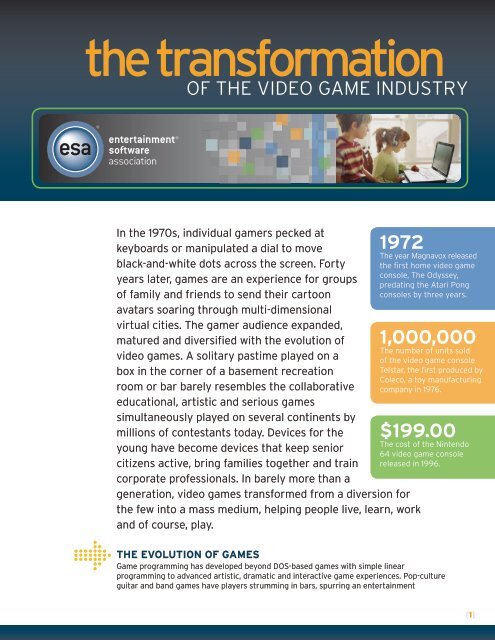Video Game Industry - Entertainment Software Association
Video Game Industry - Entertainment Software Association
Video Game Industry - Entertainment Software Association
Create successful ePaper yourself
Turn your PDF publications into a flip-book with our unique Google optimized e-Paper software.
the transformationOF THE VIDEO GAME INDUSTRYIn the 1970s, individual gamers pecked atkeyboards or manipulated a dial to moveblack-and-white dots across the screen. Fortyyears later, games are an experience for groupsof family and friends to send their cartoonavatars soaring through multi-dimensionalvirtual cities. The gamer audience expanded,matured and diversified with the evolution ofvideo games. A solitary pastime played on abox in the corner of a basement recreationroom or bar barely resembles the collaborativeeducational, artistic and serious gamessimultaneously played on several continents bymillions of contestants today. Devices for theyoung have become devices that keep seniorcitizens active, bring families together and traincorporate professionals. In barely more than ageneration, video games transformed from a diversion forthe few into a mass medium, helping people live, learn, workand of course, play.1972The year Magnavox releasedthe first home video gameconsole, The Odyssey,predating the Atari Pongconsoles by three years.1,000,000The number of units soldof the video game consoleTelstar, the first produced byColeco, a toy manufacturingcompany in 1976.$199.00The cost of the Nintendo64 video game consolereleased in 1996.THE EVOLUTION OF GAMES<strong>Game</strong> programming has developed beyond DOS-based games with simple linearprogramming to advanced artistic, dramatic and interactive game experiences. Pop-cultureguitar and band games have players strumming in bars, spurring an entertainment[1]
phenomenon to compete with karaoke. Today’s games create new worlds where playerscan manipulate and change their environment through realistic animation and uniquemotion-sensor controllers.Today’s games also do more than create virtual worlds and entertain; they help tackleimportant social issues, improve the delivery of health care, increase our chances forworkplace success, and strengthen our educational system. Nonprofit organizations andissue advocates use “serious games” as a medium to reach young tech-savvy consumers.Human rights group Breakthrough, for example, created a Facebook-based game to educateplayers on global issues including racial and sexual discrimination, immigration, laborand religious freedom. <strong>Game</strong>s also enhance traditional medical treatments. Students atChamplain College in Vermont developed a series of gamesthat use interactive activities to engage cystic fibrosispatients in traditional breathing exercises that help managetheir disease.Corporations and educational institutions have also foundvideo games to be useful tools. Companies like AmericanExpress, Bank of America, IBM, JP Morgan Chase, Nokiaand Pfizer offer interactive computer training that includesgame-like simulations. In addition, a growing numberof educators incorporate games into their lesson plansin classrooms across the country. Middle school andninth-grade teachers use the online, game-based learningplatform iCivics, conceived of by former Supreme CourtJustice Sandra Day O’Connor, to help teach civics lessons.30The averagegame player age31The percent ofentertainment softwareindustry sales revenuegenerated by purchases ofdigital game content.TODAY’S GAMERThe individuals playing video games comprise an increasingly large and definition-defyinggroup. According to the <strong>Entertainment</strong> <strong>Software</strong> <strong>Association</strong>’s (ESA) 2012 Essential FactsAbout the Computer and <strong>Video</strong> <strong>Game</strong> <strong>Industry</strong>, the average gamer is 30 years old and hasbeen playing for 12 years. Forty-seven percent of gamers are women, and women age 18or older represent 30 percent of the game-playing population. In addition, 62 percent ofgamers are adults, with 37 percent over the age of 35. As these statistics show, today’svideo game players include students, parents and grandparents.The diverse segments of the gamer group drove the evolution of games into new territory.The first gamers grew up, started families and included their children and parents in thefun, multiplying the pool of multi-generational gamers exponentially. Active and socialgames also make this pastime more appealing to family members of all ages. The ESA’s 2012Essential Facts report found that 40 percent of parents play computer and video games withtheir children at least weekly and 90 percent of parents say game play is fun for the wholefamily. Further, 62 percent of gamers play with others, either in person or online. A majorityof gamers play with their friends or family members: 16 percent play with parents, 40percent play with friends, 17 percent play with their spouse or significant other and 34 playwith other family members. Schools also use active dance, fitness and sports games likethese in gym classes to the delight of many students. Retirement communities hold videogame tournaments and receive grants to purchase video game consoles.As the population of gamers has expanded, market forces have driven game developersto make games more accessible to this new, diverse audience. Their creativity produces anever-expanding variety of games to choose from in different formats and across platforms.Right now, every product with a screen – whether a mobile phone, a PC, a TV or a handheldsystem – plays games. According to ESA’s research, 33 percent of gamers play games on theirsmartphones, and 25 percent play on their handheld device. Casual games featured on socialnetworking sites like Facebook are also growing in popularity. Online payment company PayPalreported in August 2011 that 40 percent of adults play online games, and Inside Network[2]
eported in 2010 that12 million unique users pay for virtual goods offered as part of these games each month.INDUSTRY GROWTHIn the 1970s, a handful of companies, including Atari Inc. and Magnavox, produced alimited amount of video games designed to appeal mainly to young males. In the followingdecades, competitors such as Nintendo, Sony and Namco joined the industry and companiesbegan making games that appealed to a wider audience. Today, the growth of gamers andincreased demand for games has translated into the explosive growth of the entertainmentsoftware industry. <strong>Video</strong> games are now nearly $25 billion industry in the U.S. and theESA has more than 30 member companies, including Microsoft Corporation, Nintendo ofAmerica, Sony Computer <strong>Entertainment</strong> America and Electronic Arts.The entertainment software industry is currently one of the fastest growing industries inthe American economy. Overall computer and video game industry hardware, software andperipheral sales reached $24.75 billion in 2011. Of this total, game content sales generated$16.6 billion, including $7.3 billion in purchases of digital full games, digital add-on content,mobile apps, subscriptions and social network game play. By comparison, as recently as1997, the industry generated $5.1 billion over the entire year.The industry also adds lucrative jobs to local economies with average total compensationreaching $90,000. Computer and video game companies directly and indirectly employmore than 120,000 people in 34 states.www.theESA.com© 2012 <strong>Entertainment</strong> <strong>Software</strong> <strong>Association</strong>[3]
















